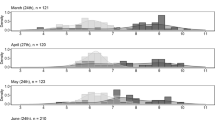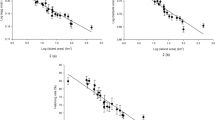Summary
Differences in maternal investment and initial offspring size can have important consequences for offspring growth and development. To examine the effects of initial size variability in the frogBombina orientalis, we reared larvae (N=360) in one of two treatments representing different levels of environmental quality. We used snout-vent length at the feeding stage (stage 25, Gosner 1960) as a measure of maternal investment. In a “low quality” treatment, larvae were reared with two conspecific tadpoles and food was limited, whereas in a “high quality” treatment, larvae were reared individually and were fed ad libitum. Among tadpoles reared in the low quality treatment, individuals that were initially small had smaller body sizes through metamorphosis and longer larval periods than individuals that were initially large. Among tadpoles reared in the high quality treatment, initial size had only a weak influence on later larval size, and did not significantly affect metamorphic size of the duration of the larval period. This interaction between maternal investment and rearing conditions suggests that production of initially small offspring could be advantageous if these offspring develop in relatively benign environments, but disadvantageous if environments are more severe. These findings are discussed in light of previous studies that have demonstrated such interactions in organisms with complex life cycles.
Similar content being viewed by others
References
Alford RA (1986) Effects of parentage on competitive ability and vulnerability to predation inHyla chrysoscelis tadpoles. Oecologia 68: 199–204
Amundsen T, Stokland JN (1990) Egg size and parental quality influence nestling growth in the shag. Auk 107: 410–413
Bagenal TB (1969) Relationship between egg size and fry survival in brown troutSalmo trutta L. Fish Biol 1: 349–353
Berven KA (1982) The genetic basis of altitudinal variation in the wood frogRana sylvatica. I. An experimental analysis of life history traits. Evolution 36: 962–983
Berven KA (1988) Factors affecting variation in reproductive traits within a population of wood frogs (Rana sylvatica). Copeia 1988: 605–615
Berven KA (1990) Factors affecting population fluctuations in larval and adult stages of the wood frog (Rana sylvatica). Ecology 71: 1599–1608
Berven KA, Chadra BG (1988) The relationship among egg size, density and food level on larval development in the wood frog (Rana sylvatica). Oecologia 75: 67–72
Berven KA, Gill DE (1983) Interpreting geographic variation in life-history traits. Am Zool 23: 85–97
Brockelman WY (1975) Competition, the fitness of offspring, and optimal clutch size. Am Nat 109: 677–699
Bull JJ (1987) Evolution of phenotypic variance. Evolution 41: 303–315
Caldwell JP, Thorp JH, Jervey TO (1980) Predator-prey relationships among larval dragonflies, salamanders, and frogs. Oecologia 46: 285–289
Capinera JL (1979) Qualitative variation in plants and insects: effect of propagule size on ecological plasticity. Am Nat 114: 350–361
Cox DR, Snell EJ (1989) Analysis of binary data, 2d ed. Chapman and Hall, New York
Crump ML (1981) Variation in propagule size as a function of environmental uncertainty for treefrogs. Am Nat 117: 724–737
Crump ML (1984) Intraclutch egg size variability inHyla crucifer (Anura: Hylidae). Copeia 1984: 302–308
Crump ML (1991) Choice of oviposition site and egg load assessment by a treefrog. Herpetologica 47: 308–315
Crump ML, Vaira M (1991) Vulnerability ofPleurodema borelli tadpoles to an avian predator: effect of body size and density. Herpetologica 47: 316–321
Falconer DS (1989) Introduction to quantitative genetics, 3d ed. John Wiley & Sons, New York
Fraser DT (1980) On the environmental control of oocyte maturation in a plethodontid salamander. Oecologia 46: 302–307
Freund RJ, Littell RC, Spector PC (1986) SAS system for linear models. SAS Institute Inc., Cary, NC
Gillespie JH (1977) Natural selection and variances in offspring numbers: a new evolutionary principle. Am Nat 111: 1010–1014
Gosner KL (1960) A simplified table for staging anuran embryos and larvae with notes on identification. Herpetologica 16: 183–190
Hamburger V (1960) A manual of experimental embryology, University of Chicago Press, Chicago, IL
Howard RD (1980) Mating behavior and mating success in wood frogs,Rana sylvatica. Anim Behav 28: 705–716
Huey RB (1980) Sprint velocity of tadpoles (Bufo boreas) through metamorphosis. Copeia 1980: 537–540
Hutchings JA (1991) Fitness consequences of variation in egg size and food abundance in brook troutSalvelinus fontinalis. Evolution 45: 1162–1168
John-Alder HB, Morin PJ (1990) Effects of larval density on jumping ability and stamina in newly metamorphosedBufo woodhousii fowleri. Copeia 1990: 856–859
Kaplan RH (1980) The implications of ovum size variability for offspring fitness and clutch size within several populations of salamanders (Ambystoma). Evolution 34: 51–64
Kaplan RH (1985) Maternal influences on offspring development in the California newt,Taricha torosa. Copeia 1985: 1028–1035
Kaplan RH (1987) Developmental plasticity and maternal effects of reproductive characteristics in the frog,Bombina orientalis. Oecologia 71: 273–279
Kaplan RH (1989) Ovum size plasticity and maternal effects on the early development of the frog,Bombina orientalis, in a field population in Korea. Funct Ecol 3: 597–604
Kaplan RH (1992) Greater maternal investment can decrease offspring survival in the frog,Bombina orientalis. Ecology 73: 280–288
Kaplan RH, Cooper WS (1984) The evolution of developmental plasticity in reproductive characteristics: an application of the “adaptive coin-flipping” principle. Am Nat 123: 393–410
Kaplan RH, Cooper WS (1988) On the evolution of coin-flipping plasticity: a response to McGinley, Temme, and Geber. Am Nat 132: 753–755
Kaplan RH, Salthe SN (1979) The allometry of reproduction: an empirical view in salamanders. Am Nat 113: 671–689
Kawamura T, Nishioka M, Ueda H (1972) Reproduction of the oriental fire-bellied toad,Bombina orientalis, with special reference to the superiority of this species as a laboratory animal. Sci Rep Lab Amphibian Biol, Hiroshima University 1: 303–317
Korotkova EB (1978) Ecology of the orange-bellied toad in the Maritime Province. Ekologiya 4: 106–107
Kusano T, Kusano H, Miyashita K (1985) Size-related cannibalism among larvalHynobius nebulosis. Copeia 1985: 472–476
Lessels CM, Cooke F, Rockwell RF (1989) Is there a trade-off between egg weight and clutch size in wild Lesser snow geese (Anser c. caerulescens)? J Evol Biol 2: 457–472
Marsh E (1986) Effects of egg size on offspring fitness and maternal fecundity in the orangethroat darter,Etheostoma spectabile (Pisces: Percidae). Copeia 1986: 18–30
Marshall CJ, Doyle LS, Kaplan RH (1990) Intraspecific and sex-specific oophagy in a salamander and a frog: reproductive convergence ofTaricha torosa andBombina orientalis. Herpetologica 46: 395–399
McGinley MA, Temme DH, Geber MA (1987) Parental investment in offspring in variable environments: theoretical and empirical considerations. Am Nat 130: 370–398
Meffe GK (1987) Embryo size variation in mosquitofish: optimality vs. plasticity in propagule size. Copeia 1987: 762–768
Milliken GA (1984) SAS tutorial: analysis of covariance — models, strategies and interpretations. In: Proc. ninth ann. SAS users group intl. conference. SAS Institute Inc. Cary, NC, pp 990–999
Morris DW (1987) Optimal allocation of parental investment. Oikos 49: 332–339
Newman RA (1987) Effects of density and predation onScaphiopus couchi tadpoles in desert ponds. Oecologia 71: 301–307
Newman RA (1989) Adaptive plasticity in development ofScaphiopus couchii tadpoles in desert ponds. Evol 42: 774–783
Parichy DM, Kaplan RH (1992) Developmental consequences of tail injury on larvae of the oriental fire-bellied toad,Bombina orientalis. Copeia 1992: 129–137
Petranka JW, Sih A (1987) Habitat duration, length of the larval period, and the evolution of a complex life cycle of a salamander,Ambystoma texanum. Evolution 41: 1347–1356
Philippi T, Seger J (1989) Hedging one's evolutionary bets, revisited. Trends Ecol Evol 4: 41–44
Phillips PC, Kaplan RH (1987) A personal computer-microscope interface for the analysis of size and shape. Herpetologica 43: 384–385
Reid WV, Boersma PD (1990) Parental quality and selection on egg size in the magellanic penguin. Evolution 44: 1780–1786
Richards CM (1962) The control of tadpole growth by algal-like cells. Physiol Zool 35: 285–296
Richards SJ, Bull CM (1990) Size-limited predation on tadpoles of three Australian frogs. Copeia 1990: 1041–1046
Rossiter MC (1991) Maternal effects generate variation in life history: consequences of egg weight plasticity in the gypsy moth. Funct Ecol 5: 386–393
SAS Institute Inc. (1988) SAS/STAT user's guide, release 6.03 ed. Cary, NC
Schultz DL (1989) The evolution of phenotypic variance with iteroparity. Evolution 43: 473–475
Schultz DL (1991) Parental investment in temporally varying environments. Evol Ecol 5: 415–427
Selcer KW (1990) Egg-size relationships in a lizard with a fixed clutch size: variation in a population of the Mediterranean gecko. Herpetologica 46: 15–21
Semlitsch RD, Caldwell SJ (1982) Effects of density on growth, metamorphosis, and survivorship in tadpoles ofScaphiopus holbrooki. Ecology 63: 905–911
Semlitsch RD, Gibbons JW (1990) Effects of egg size on success of larval salamanders in complex aquatic environments. Ecology 71: 1789–1795
Semlitsch RD, Scott DE, Pechman JHK (1988) Time and size at metamorphosis related to adult fitness inAmbystoma talpoideum. Ecology 69: 184–192
Shrode JB, Gerking SD (1977) Effect of constant and fluctuating temperatures on reproductive performance of a desert pupfish,Cyprinodon n nevadensis. Physiol Zool 50: 1–10
Sinervo B (1990) The evolution of maternal investment in lizards: an experimental and comparative analysis of egg size and its effects on offspring performance. Evolution 44: 279–294
Smith CK (1990) Effects of variation in body size on intraspecific competition among larval salamanders. Ecology 71: 1777–1788
Smith CC, Fretwell SD (1974) The optimal balance between size and number of offspring. Am Nat 108: 499–506
Smith DC (1987) Adult recruitment in chorus frogs: effects of size and date at metamorphosis. Ecology 68: 344–350
Smith DC (1990) Population structure and competition among kin in the chorus frog (Pseudacris triseriata). Evolution 44: 1529–1541
Sokal RR, Rohlf FJ (1981) Biometry, 2d ed. WH Freeman and Company, New York
Steinwascher K (1979) Competitive interactions among tadpoles: responses to resource level. Ecology 60: 1172–1183
Taigen TL, Pough FH (1981) Activity metabolism of the toad (Bufo americanus): ecological consequences of ontogenetic change. J Comp Physiol 144: 247–252
Takahashi H, Iwasawa H (1988) Interpopulation variations in clutch size and egg size in the Japanese salamander,Hynobius nigrescens. Zool Sci (Tokyo) 5: 1073–1081
Tessier AJ, Consolatti NL (1989) Variation in offspring size inDaphnia and consequences for individual fitness. Oikos 56: 269–276
Thomas CS (1983) The relationships between breeding experience, egg volume and reproductive success of the kittiwakeRissa tridactyla. Ibis 125: 567–574
Travis J (1983) Variation in growth and survival ofHyla gratiosa larvae in experimental enclosures. Copeia 1983: 232–237
Travis J (1984) Anuran size at metamorphosis: expeimental test of a model based on intraspecific competition. Ecology 65: 1155–1160
Venable DL, Brown JS (1988) The selective interactions of dispersal, dormancy, and seed size as adaptations for reducing risk in variable environments. Am Nat 131: 360–384
Wassersug RJ, Sperry DG (1977) The relationship of locomotion to differential predation onPseudacris triseriata (Anura: Hylidae). Ecology 68: 830–839
Wilbur HM (1977) Density-dependent aspects of growth and metamorphosis inBufo americanus. Ecology 58: 196–200
Wilbur HM (1980) Complex life cycles. Ann Rev Ecol Syst 11: 67–93
Wilbur HM, Collins JP (1973) Ecological aspects of amphibian metamorphosis. Science 182: 1305–1314
Wilbur HM, Morin PJ, Harris RN (1983) Salamander predation and the structure of experimental communities: anuran responses. Ecology 64: 1423–1429
Williamson I, Bull CM (1989) Life history variation in a population of the Australian frogRanidella signifera: egg size and early development. Copeia 1989: 349–356
Winer BJ (1971) Statistical principles in experimental design, 2d ed. McGraw-Hill Book Co, New York
Winkler DW, Wallin K (1987) Offspring size and number: a life history model linking effort per offspring and total effort. Am Nat 129: 708–720
Woodward BD (1983) Tadpole size and predation in the Chihuahuan desert. Southwest Nat 28: 470–471
Woodward BD (1987) Interactions between Woodhouse's toad tadpoles (Bufo woodhousii) of mixed sizes. Copeia 1987: 380–386
Author information
Authors and Affiliations
Rights and permissions
About this article
Cite this article
Parichy, D.M., Kaplan, R.H. Maternal effects on offspring growth and development depend on environmental quality in the frogBombina orientalis . Oecologia 91, 579–586 (1992). https://doi.org/10.1007/BF00650334
Received:
Accepted:
Issue Date:
DOI: https://doi.org/10.1007/BF00650334




